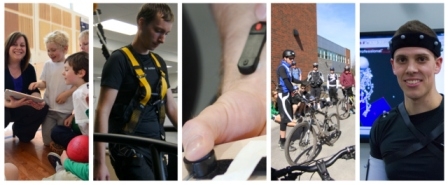Physical activity for healthy living at NU’s new centre

Researchers in Nipissing’s Centre for Physical and Health Education are studying how physical activity can promote healthy living and solve health issues as diverse as lower back pain, improving quality of life for cancer patients, recovery from concussion and helping kids be more active. The research benefits students, as well as the community, and the university is pleased to welcome everyone to the grand opening of the Centre for Physical Health and Education, Friday, October 3, 2014 at 1:00 p.m.
The centre combines research, teaching and physical activity to support a holistic approach to learning and healthy living. It represents a $7.5 million investment for studying and teaching human movement science, and for knowledge creation relevant to the societal, health and business challenges facing communities.
“This is a fantastic new facility that has been designed to benefit Nipissing’s students and faculty as well as our community and region,” said Dr. Mike DeGagné, president and vice-chancellor of Nipissing University. “Thank you to Northern Ontario Heritage Fund, which provided $1 million in funding to help us realize our goals and make this building a reality.”
“This is an exciting event for the faculty and students in the School of Physical and Health Education. The state-of-the-art labs and equipment create a lot of opportunities for us to extend our teaching and research into how people move and investigate ways to improve the health of our communities through physical activity,” said Dr. Jim McAuliffe, director of the School of Physical and Health Education. “It’s important to welcome our community today, as we are looking to build partnerships to help propel research innovations.”
As part of the grand opening, tours will be offered of the state-of-the-art laboratories, including:The Sensory Movement Behaviour Lab houses specialized equipment to monitor eye movements and evaluate autonomic nervous system (ANS) function, visual attention, and visual control of movement. It incorporates soundproof testing areas, a motion capture system and a specialized space to monitor electrocardiogram and ANS function.The Exercise Physiology Lab is a state-of-the-art teaching and research laboratory which is capable of monitoring human muscular, cardiovascular, respiratory, and biochemical responses to exercise. It is one of only a few centres in the world that features an Environmental Chamber, for studying human physiology over a range of climates (e.g. extreme heat to extreme cold, high and low altitude, dry or humid conditions), as well as a force-sensing treadmill to analyze human movement and force.The Psychology of Physical Activity and Health Promotion Lab supports emerging research on psychological aspects associated with physical activity and health behaviours. It includes a camera-equipped fitness studio, an interview room, and data analysis areas to examine and provide feedback on physical activity interventions, and health behaviour change techniques.The Biomechanics and Ergonomics Lab studies human movement. The lab contains technologically advanced systems for motion capture, force measurement, and muscle activity analysis to help understand and model the physical factors that act on the body during work, exercise, and sport. These systems provide invaluable feedback for the prevention and rehabilitation of musculoskeletal injuries and neurological disorders, and provide a better understanding of how the body moves.
